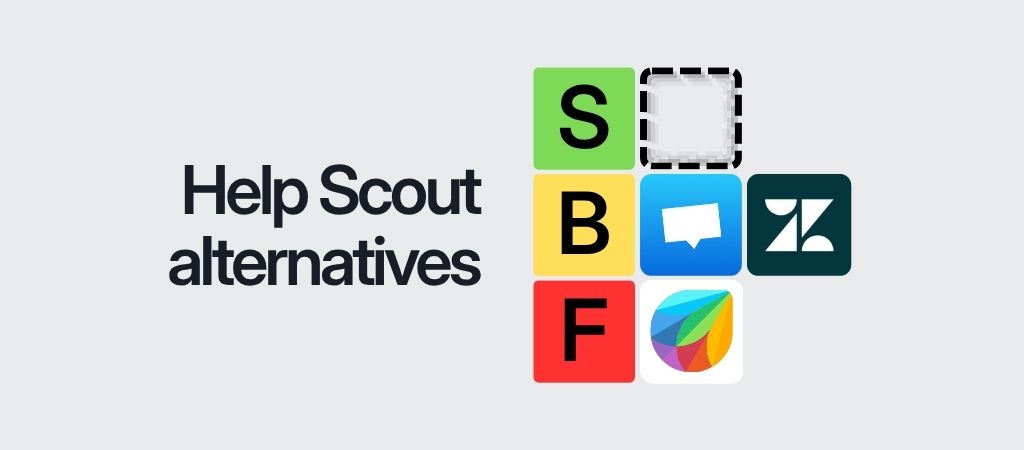In this guide I will help you find the best Help Scout alternative to use for your business in 2025.
Short answer:
The best Help Scout alternatives are:
- If you just want live chat, use Intercom. (Starts at $39/seat per month)
- If you are a larger business, I would recommend Zendesk. (Starts at $55/agent per month)
- If you need AI phone support for Shopify, use Ringly.io. You only start paying for Ringly when your AI phone agent resolves at least 60% of your support calls.
Ringly averages a 73% resolution rate on over 2,100 active Shopify stores.
See the TL;DR table below for a quick comparison from all the tools that I tested.
Below the TL;DR table you will find an in-depth review for every single tool as well.
How I tested each tool: stopwatch from signup → onboarded. I installed the tool on a Shopify store, installed all the basic features, just the ones that I need to get started.
Note: All of these tools cover the basics. I’ll only go over standout features that are unique to each tool specifically.
TLDR of Help Scout alternatives
1. Ringly.io: AI phone support for Shopify stores
Best for Shopify stores looking for the best way to offer 24/7 AI phone support at a fraction of the cost.
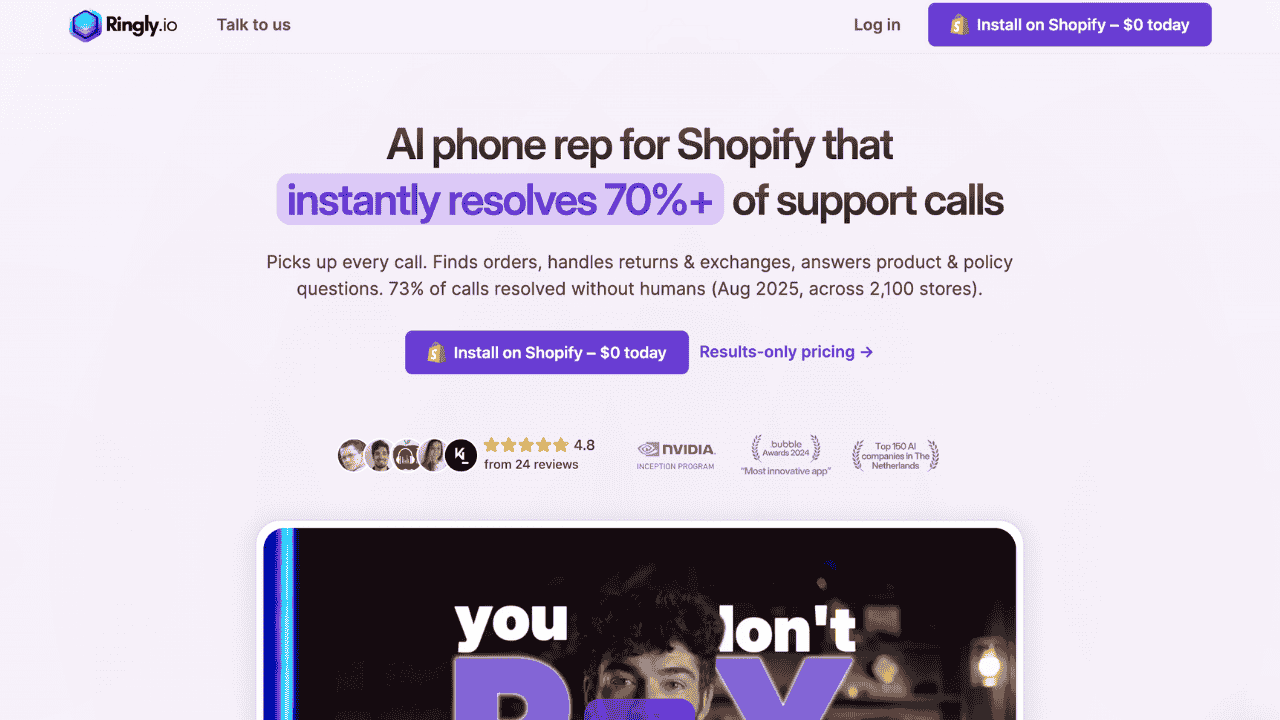
How it went when I tried setting up Ringly:
After I installed the Shopify app, the only thing I had to do was to upload my data to the knowledge base. (website was uploaded automatically) After I did that, I could already speak to my agent via a web call.
Setting it live was as simple as picking a phone number with my area code from the dashboard. I was able to connect the number with 1 click. (The number is also free and included)
There was not really anything else to the setup. They claim that out of the box, their agents resolve an average of 73% of support calls. They back that up with data from over 2,100 active Shopify stores.
Signup -> onboarded took only 4 minutes and 12 seconds. Most of that time was spent waiting for the knowledge to be uploaded. Over the first 2 weeks I used it (14-day free trial), it resolved 76% of my calls on its own.
The rest of the calls were escalated to a support ticket by my agent.
(update: the more calls you get, the smarter it gets. As of today, my resolution rate is 79%.)
Standout Features (pros):
- Very easy setup (almost none)
- Pay on results pricing
Pricing is on a results basis; you don't pay until your agent has at least a 60% resolution rate
Shopify integration is native. It will allow your agent to solve order status and refund requests on the phone.
Reviews are overall very positive, mainly because of the results-based pricing. If you don't pay unless you get results, every customer gets results.
Cons:
- Phone support only
What’s unique about Ringly is that it is the first AI phone support tool built for Shopify.
Editors note: Ringly.io opened 5 spots for Shopify stores to pay $0 until AI resolves 60% of your support calls. You can book a call to claim it.
2. Zendesk: battle-tested enterprise support tool
Best for larger businesses that are leaning toward enterprise.
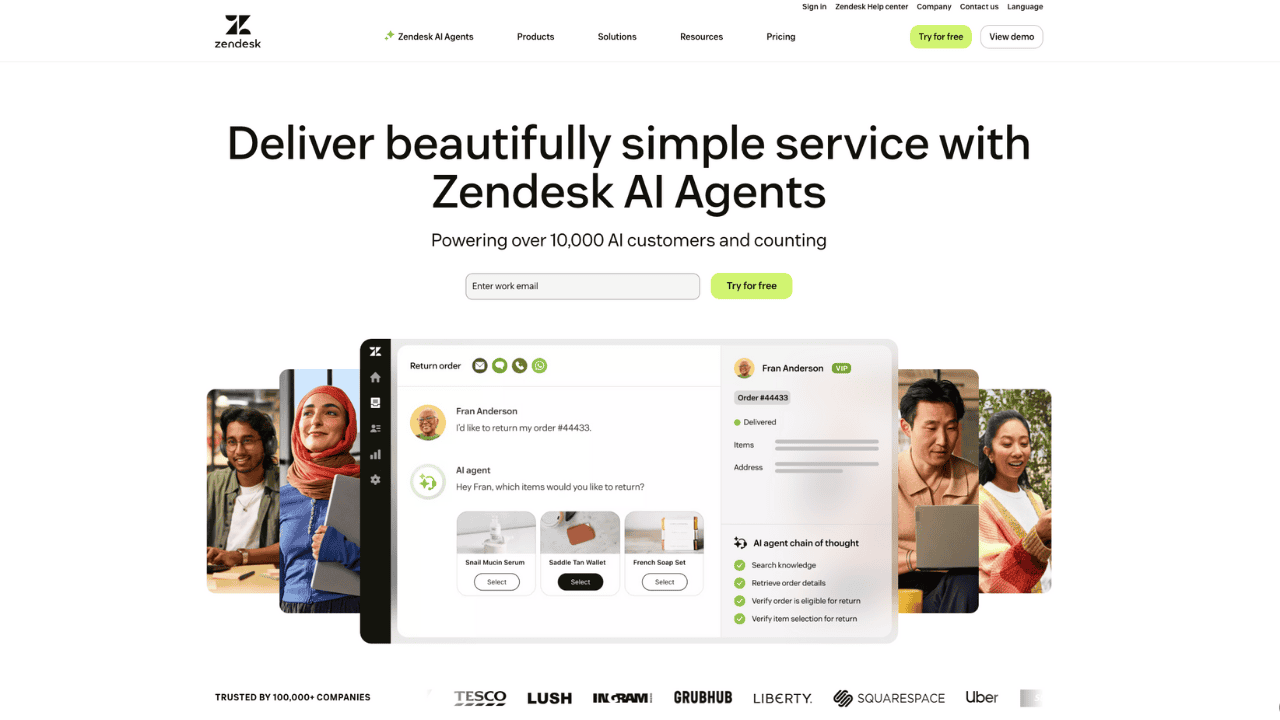
How it went when I tried setting up Zendesk:
After signup they will guide you through all the steps required to get started. They immediately ask for your website to start training the AI agent.
After that, you will be guided through a demo ticket resolution, which was very helpful. Especially since the dashboard is a bit more complicated.
When using Zendesk over a period of 2 weeks, I mostly felt that I was not using most of the features. So if you are a smaller to medium-sized ecommerce brand, I would not recommend this tool for you.
The product functions perfectly, though, and there were some things, like the macros feature, that I liked.
The AI agent is also decent, but I would say it not not as capable as some other agents that I have tested. It is mostly for filtering out the really simple tasks.
Signup -> onboarded took me exactly 17 minutes and 51 seconds. In that time, I set up the AI agent, invited my team, and set up all the routing rules for tickets.
Standout Features (pros):
- Scalable
- Older and proven platform
- A big ecosystem with other tools
Pricing starts from $55 per agent per month.
Shopify integration (is available through a native Shopify app that syncs order/customer data into tickets.
Reviews are not the best; on Trustpilot, they only score 1.9 out of 5, but on Capterra, they score 4.4 out of 5.
A common complaint is the lack of support available, billing issues, and people who feel they were misled.
On the flip-side, some people say their support and platform are great, so reviews are mixed on several occasions.
Cons:
- Difficult to use
- Per agent pricing will get expensive fast
What’s unique about Zendesk is that you will probably never grow out of it.
3. Freshdesk: Affordable automation for growing teams
Best for growing teams that need a simple solution with automation capabilities.
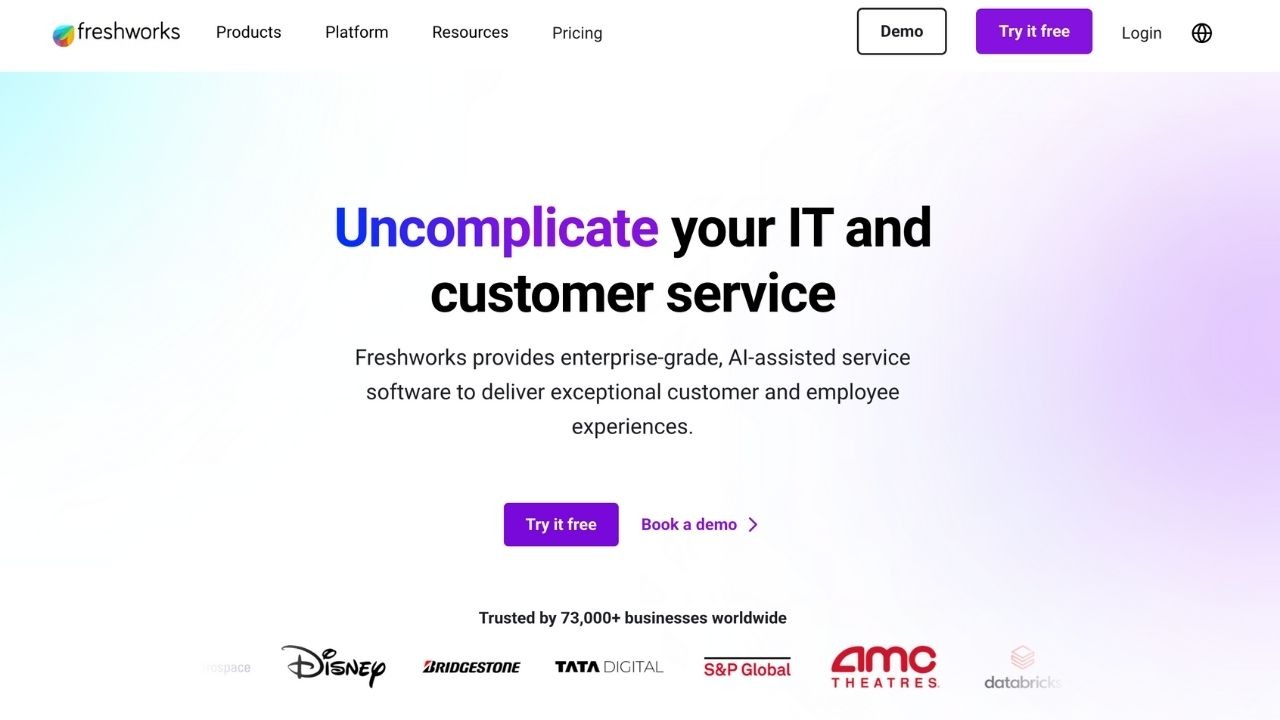
How it went when I tried setting up Freshdesk:
After signing up, they immediately ask you if you have used similar helpdesk tools before. I selected that I did not, and they sent me to a page with step-by-step instructions and videos to help me get started..
They break up the onboarding into 3 steps: connecting your email, getting to know the dashboard and inviting your teammates. The only thing I had to do was follow along exactly with these steps.
Their dashboard looks very good and is easy to navigate. Unlike other tools, they also prefill data fields with dummy data, so it is significantly easier to understand what those features are.
One other thing that stood out that I liked was the confetti visuals every time I succeeded with a step in the onboarding.
Signup -> onboarded took me only 9 minutes and 41 seconds. Their onboarding is one of the best I have seen.
Standout Features (pros):
- Onboarding
- Very good knowledge base that adapts
- Most things are already set up when you give them your website
Pricing starts at $15/month per agent, and they offer a free trial.
Shopify integration is not native, but it does allow ticket creation directly from Shopify.
Reviews are mixed; on Trustpilot, they score a 2.6 /6, and on Capterra, they scored 4.5 /5
Most bad reviews were because of either the product not living up to expectations or claims of bad business practices.
The positive reviews often mentioned the high level of support, and there were also a lot of people that are very satisfied with the product.
In my opinion, most of the bad reviews come across as angry customers who were not really fair in their judgment.
Cons:
- Some newer features are a bit chaotic
- Not a lot of customization on the lower tiers
What’s unique about Freshdesk is that they offer enterprise-level automation features for normal non-enterprise pricing, and they are also easy to get started with.
4. Intercom: proactive, product lead engagement
Best for SaaS and product lead companies.
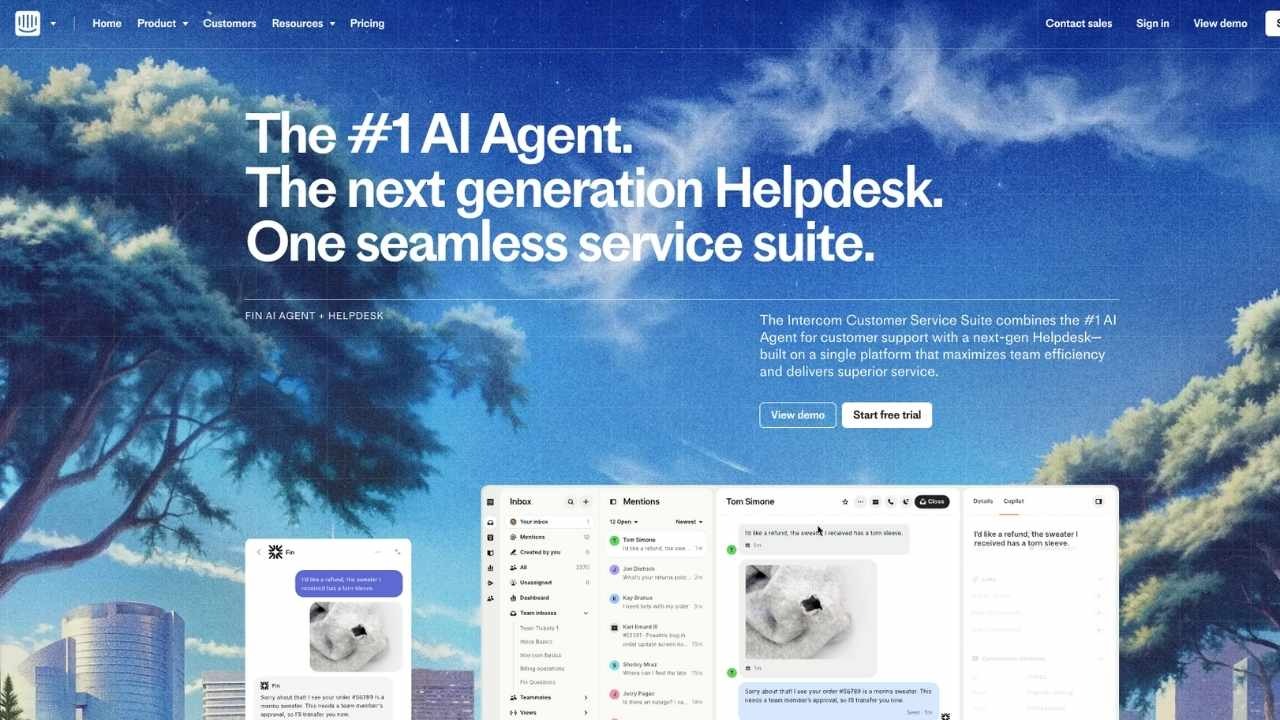
How it went when I tried setting up Intercom:
You have to start a trial to get access to the platform, but you don’t need to give them your card details. After I signed up, they asked if you have experience using similar tools.
I selected that I did not, and I was sent to a page showing the 5 onboarding steps to get started. I just needed email and chat support.
Setting up the chat was pretty simple. I used the Shopify plugin to add it to my website. Email, on the other hand, is a bit more difficult because you need to set up email forwarding.
But the documentation was very clear and useful, so I did not really have any problems.
The next thing they asked me to set up was their AI agent called Fin. This is a product that they also sell separately, but using it together with Intercom makes it even better in my opinion.
Training the agent is as simple as choosing from templates and adding your knowledge.
Signup -> onboarded took me a bit longer, 16 minutes and 21 seconds, which is mainly because of the large amount of features they offer.
And although these features are complex and robust, they make setting them up very accessible.
Standout Features (pros):
- Fin AI, beat AI chat agent available right now
- Best looking UI
- All-in-one solution
Pricing starts at $39/seat per month, and Fin AI is charged per solved resolution. ($0,99)
Shopify integration will sync customer data and trigger messages based on store behavior.
Reviews are pretty good, a 3.1/5 on Trustpilot and a 4.5/5 on Capterra. Most people are happy about the fact that this one platform offers an all-in-one solution.
The negative reviews were mainly about the pricing or their support not being good enough.
Cons:
- Pricing, AI resolutions, and seats are way more expensive
- Steeper learning curve
What’s unique about Intercom is that it combines support, sales, and onboarding into one tool. Intercom is not really an e-commerce help desk, but more focused on SaaS and product lead companies.
5. Zoho Desk: enterprise features without enterprise pricing
Best for businesses that are already in the Zoho ecosystem.
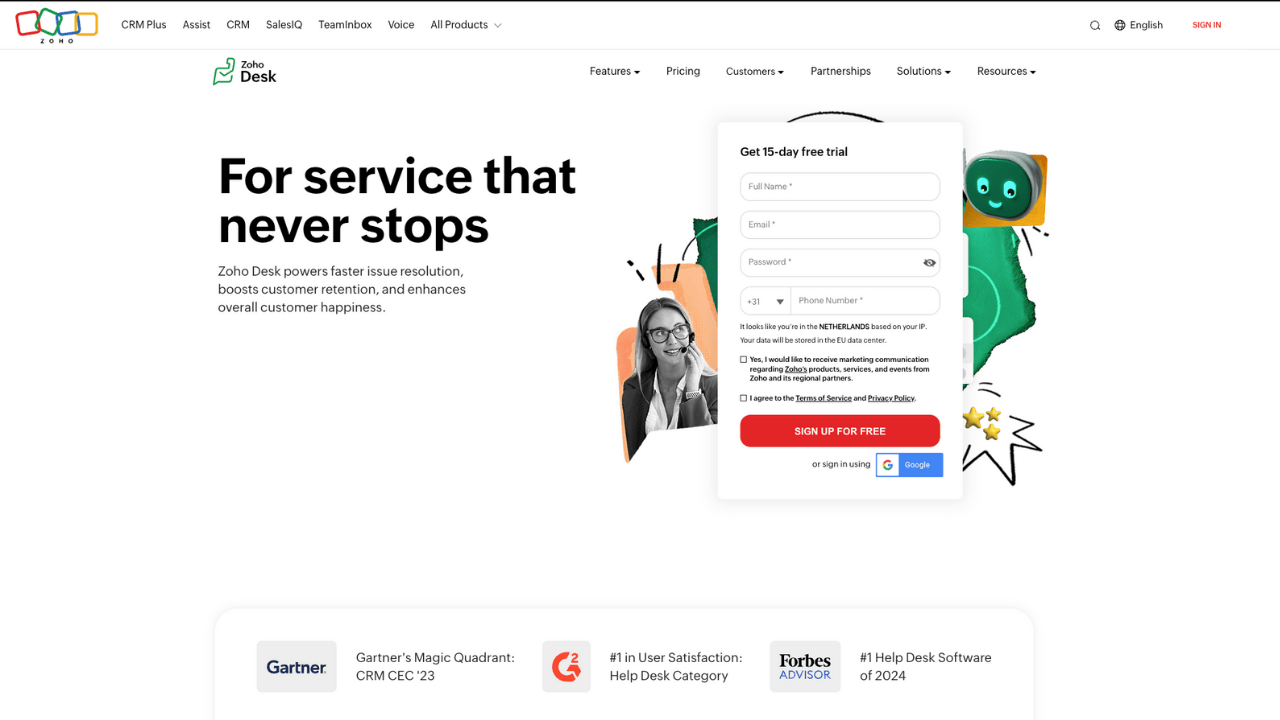
How it went when I tried setting up Zoho Desk:
After signing up, the only things I got shown were pop-ups to sign up for some event; there was not really an onboarding experience.
So I tried to set up the platform myself, and it is very different from the other platforms I tested. For instance, they sort tickets in a pipeline, kind of like you would with leads in a CRM. This seemed odd to me at first, but it does make sense once you start using the tool.
This feature also gives your team a positive feeling every time they can drag tickets to the finished section.
Overall, the platform is very simple; it does what it needs to do and not much more. They also have analytics, but they are not special.
One thing I missed was some sort of AI feature; it seems like they don’t offer any AI features for their helpdesk yet.
Signup -> onboarded took me not that long because there was not much to set up. It is basically only a ticketing tool, and the setup was done in 11 minutes and 19 seconds.
Standout Features (pros):
- Context-aware ticketing
- Integrations with other Zoho apps
- Affordable
Pricing starts for free up to 3 seats; after that, it is $14/month per seat.
Shopify integration is not native, so it requires a more manual setup, but it does the basic stuff like sharing order and customer info with the helpdesk.
Reviews are only available on Capterra, and they score a 4.5/5. Most users report a good user experience, but weird bugs are a common theme.
Cons:
- UI is a bit dated
- I found more bugs with things like uploading larger datasets
- No AI
What’s unique about Zoho Desk is that it has a very generous free plan, and Zoho also offers other tools besides just a help desk.
6. Liveagent: (plain-English one-sentence verdict)
Best for teams that need multichannel support on a budget.
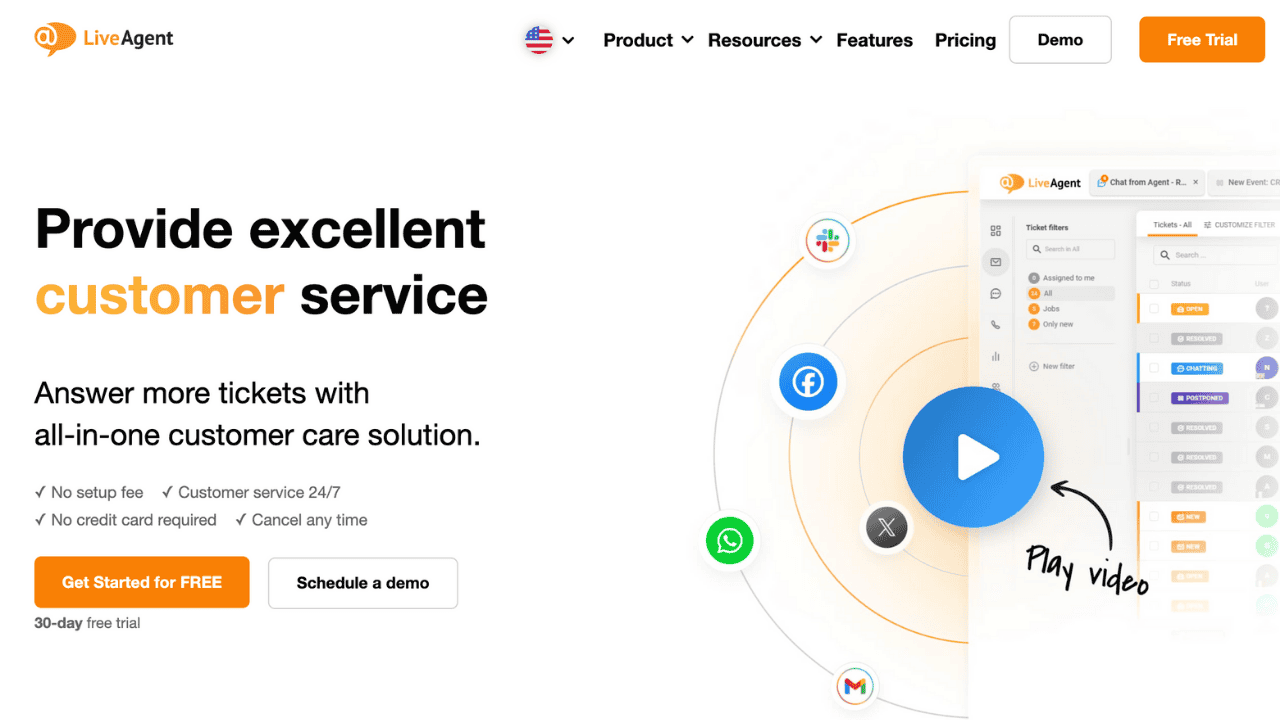
How it went when I tried setting up LiveAgent:
After signup I was redirected to a quite confusing onboarding page, where I could select my preferred channels.
I only later discovered that this was, in fact, not the onboarding page, but I had to go to my email inbox to set up my password first. So a confusing start, I would say.
Once I had access to the dashboard, I could start the onboarding, which consisted of 9 steps, and was well explained, but it was a lot of information at once.
I did manage to get through it, and connected all my social channels, installed the live chat on my Shopify store manually by putting the code in the header, and I also set up a phone support number.
Setting up their AI chatbot was pretty confusing and not intuitive at all. I think this is a newer feature that is not really optimized yet.
I did like the map they gave me, where I could see the location of my customers. But it was a bit clunky, and that was the overall feeling of the platform. At times, it was slow and felt dated.
After 2 weeks of using the platform, I experienced a capable helpdesk with lots of support channels, but there were definitely irritations while using the platform.
Signup -> onboarded took me quite a while, 23 minutes and 12 seconds. I did set up a lot of channels, though, including phone support.
I struggled the most with getting the AI agent to function properly, and still, after using that for 2 weeks and tweaking it, it did not get me the results I expected.
Standout Features (pros):
- Built-in VoIP call center
- Gamification tools
Pricing starts at $9/month per seat.
Shopify integration allows for order data and customer data to be shared with LiveAgent.
Reviews are, to my surprise, pretty good; they score a 4/5 on Trustpilot, they have no 1-star reviews there, and all the worst complaints I could find were that there was a notification bug. On Capterra, they score a whopping 4.7 out of 5.
Cons:
- UI feels dated
- Not a lot of options for integrations
What’s unique about Live Agent is that it offers omnichannel support and a lot of normally more expensive features at entry-level pricing.
7. Crisp: a budget all in one solution
Best for medium-sized businesses that need omnichannel support in one tool.
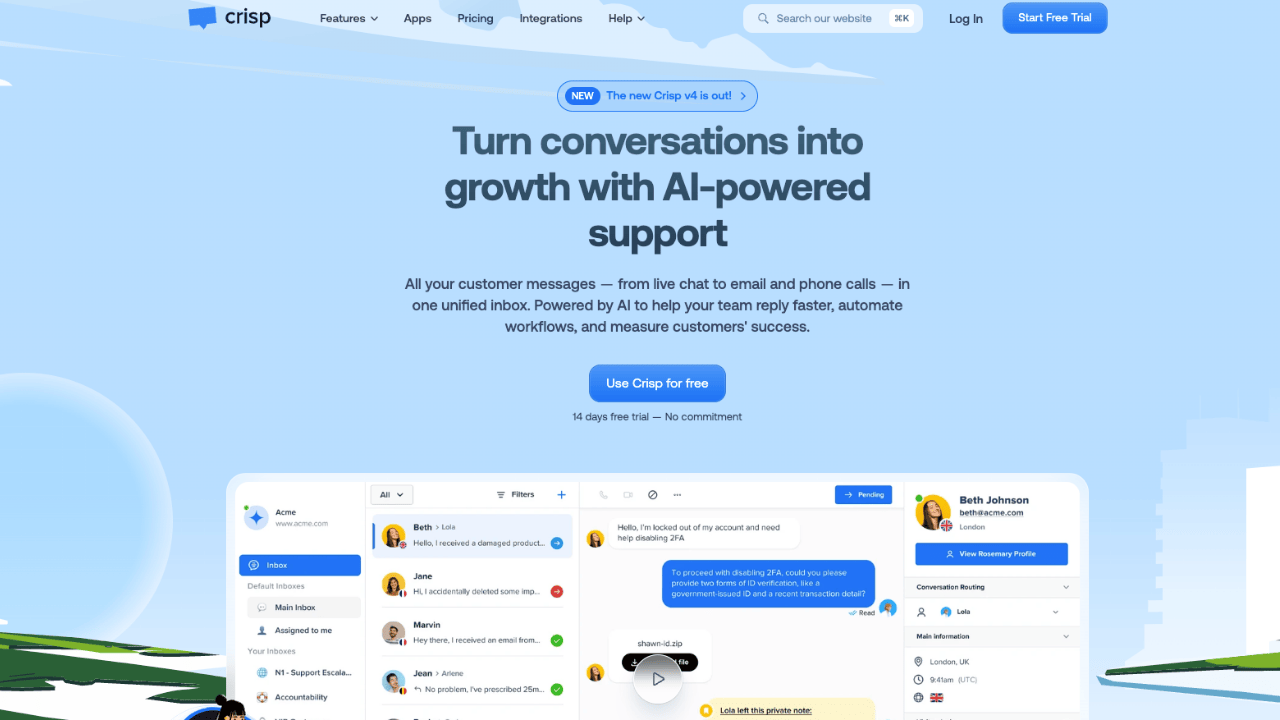
How it went when I tried setting up Crisp:
Immediately after the signup, I was met with an onboarding page with a lot of information and tasks to get done. This was a bit overwhelming. (in total, there were 26 steps)
Adding the chat widget to my website was easy to do with the Shopify plugin, and this was also the case for connecting my other channels, such as WhatsApp, email, and Messenger.
The onboarding goes quite a lot further than most other tools; for instance, they make customizing the web widget also a part of the onboarding.
After 2 weeks of using the tool, I was very satisfied with the overall feel of the platform and how the inbox and ticket management are set up, but the chatbot disappointed me.
They give you a template when you build your first chatbot, but the no-code flow builder, which is required to set up a chatbot, feels a bit clunky.
I would have much rather had a tool with a simpler setup, and that was already pre-trained on a specific use case.
Signup -> onboarded took me quite a while, and I did not even finish all of the onboarding steps. In total, I spent 24 minutes and 23 seconds setting up my live chat and AI chatbot, plus training my knowledge base and setting up some automations and routing rules.
Standout Features (pros):
- Generous free tier with unlimited conversations
- Multichannel at a low price
Pricing starts at the free tier, paid from $25/seat per month.
Shopify integration is a native Shopify app that syncs customer info and other shop data with the helpdesk. It will also allow you to connect the web widget more easily.
Reviews are not always positive. On Trustpilot, they only score 1.9 stars out of 5, and on Capterra, they score a 4.6 /5.
People are positive about the help desk and the support they offer, but there were also a lot of mentions about bugs, and people complaining about bad support. So on those topics, people are divided.
Cons:
- No advanced analytics
- Feels more “all-in-one” instead of best-in-class
What’s unique about Crisp is that it offers unlimited conversations (with limited functionality) for free. So you only have to upgrade if you want the better features, but you will probably end up doing so.
What to look for in a Help Scout alternative (5 things)
- Make sure the tool you pick connects to your e-commerce platform.
- Does the tool offer multiple channels?
- Think of how much of your support AI should handle, and what tool offers that capability.
- Can the tool scale without having to hire more humans?
- Does the pricing model fit with your business?
What does Help Scout actually do:
Help Scout is a support/customer management platform that helps you keep in touch with your customers. They offer support across multiple channels and features like AI chatbots and automation.
But like most other support platforms, they do not offer everything. One thing Help Scout does not offer is AI phone support.
Conclusion: How to choose the right alternative to Help Scout
Finding the right tools to go with for your business can be difficult because, ideally, you want to get this decision right the first time. My advice is not to focus on shiny features or finding the absolute cheapest solution. The goal should be to give your customers the best experience possible.
If you want AI phone support, Ringly.io is the best option. (Tip from me, you can plug in Ringly to a ticket helpdesk, and completely automate your phone support that way.)
If you want live chat, Intercom and Crisp are good options.
If you are a large brand, Zendesk is probably your best option.
While deciding, keep your specific e-commerce use cases in mind and make sure the support platform you pick will:
- Make your customers happier
- Not cost you a fortune
That's all for this article, hopefully it will help you to make a decision!
If you have questions on how to set up good support. Find out how Ringly.io is helping merchants like you save time and money.



